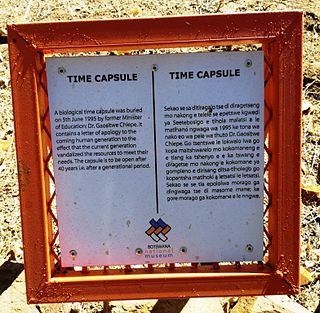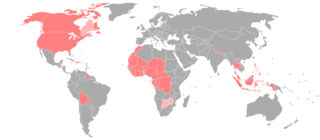Related Research Articles

American Sign Language (ASL) is a natural language that serves as the predominant sign language of Deaf communities in the United States of America and most of Anglophone Canada. ASL is a complete and organized visual language that is expressed by employing both manual and nonmanual features. Besides North America, dialects of ASL and ASL-based creoles are used in many countries around the world, including much of West Africa and parts of Southeast Asia. ASL is also widely learned as a second language, serving as a lingua franca. ASL is most closely related to French Sign Language (LSF). It has been proposed that ASL is a creole language of LSF, although ASL shows features atypical of creole languages, such as agglutinative morphology.

Sign languages are languages that use the visual-manual modality to convey meaning, instead of spoken words. Sign languages are expressed through manual articulation in combination with non-manual markers. Sign languages are full-fledged natural languages with their own grammar and lexicon. Sign languages are not universal and are usually not mutually intelligible, although there are also similarities among different sign languages.

William Clarence Stokoe Jr. was an American linguist and a long-time professor at Gallaudet University. His research on American Sign Language (ASL) revolutionized the understanding of ASL in the United States and sign languages throughout the world. Stokoe's work led to a widespread recognition that sign languages are true languages, exhibiting syntax and morphology, and are not only systems of gesture.
Martha's Vineyard Sign Language (MVSL) was a village sign-language that was once widely used on the island of Martha's Vineyard from the early 18th century to 1952. It was used by both deaf and hearing people in the community; consequently, deafness was not a barrier to participation in public life. Deaf people who signed Martha's Vineyard Sign Language were extremely independent.
Signing Exact English is a system of manual communication that strives to be an exact representation of English language vocabulary and grammar. It is one of a number of such systems in use in English-speaking countries. It is related to Seeing Essential English (SEE-I), a manual sign system created in 1945, based on the morphemes of English words. SEE-II models much of its sign vocabulary from American Sign Language (ASL), but modifies the handshapes used in ASL in order to use the handshape of the first letter of the corresponding English word.
Cued speech is a visual system of communication used with and among deaf or hard-of-hearing people. It is a phonemic-based system which makes traditionally spoken languages accessible by using a small number of handshapes, known as cues, in different locations near the mouth to convey spoken language in a visual format. The National Cued Speech Association defines cued speech as "a visual mode of communication that uses hand shapes and placements in combination with the mouth movements and speech to make the phonemes of spoken language look different from each other." It adds information about the phonology of the word that is not visible on the lips. This allows people with hearing or language difficulties to visually access the fundamental properties of language. It is now used with people with a variety of language, speech, communication, and learning needs. It is not a sign language such as American Sign Language (ASL), which is a separate language from English. Cued speech is considered a communication modality but can be used as a strategy to support auditory rehabilitation, speech articulation, and literacy development.
Hawaiʻi Sign Language, also known as Hoailona ʻŌlelo and Old Hawaiʻi Sign Language, is an indigenous sign language native to Hawaiʻi. Historical records document its presence on the islands as early as the 1820s, but HSL was not formally recognized by linguists until 2013.
The recorded history of sign language in Western societies starts in the 17th century, as a visual language or method of communication, although references to forms of communication using hand gestures date back as far as 5th century BC Greece. Sign language is composed of a system of conventional gestures, mimic, hand signs and finger spelling, plus the use of hand positions to represent the letters of the alphabet. Signs can also represent complete ideas or phrases, not only individual words.
Manually Coded English (MCE) is a type of sign system that follows direct spoken English. The different codes of MCE vary in the levels of directness in following spoken English grammar. There may also be a combination with other visual clues, such as body language. MCE is typically used in conjunction with direct spoken English.

German Sign Language or Deutsche Gebärdensprache (DGS), is the sign language of the deaf community in Germany, Luxembourg and in the German-speaking community of Belgium. It is unclear how many use German Sign Language as their main language; Gallaudet University estimated 50,000 as of 1986. The language has evolved through use in deaf communities over hundreds of years.
Icelandic Sign Language is the sign language of the deaf community in Iceland. It is based on Danish Sign Language; until 1910, deaf Icelandic people were sent to school in Denmark, but the languages have diverged since then. It is officially recognized by the state and regulated by a national committee.
Singapore Sign Language, or SgSL, is the native sign language used by the deaf and hard of hearing in Singapore, developed over six decades since the setting up of the first school for the Deaf in 1954. Since Singapore's independence in 1965, the Singapore deaf community has had to adapt to many linguistic changes. Today, the local deaf community recognises Singapore Sign Language (SgSL) as a reflection of Singapore's diverse linguistic culture. SgSL is influenced by Shanghainese Sign Language (SSL), American Sign Language (ASL), Signing Exact English (SEE-II) and locally developed signs.

The official language of Botswana is English, while Tswana is considered to be a national language. English, which was inherited from colonial rule, is the language of official business and most written communication. Most of the population speak Tswana, but over 20 smaller languages are also spoken. Some of the country's languages are in danger of becoming extinct.
American Sign Language literature is one of the most important shared cultural experiences in the American deaf community. Literary genres initially developed in residential Deaf institutes, such as American School for the Deaf in Hartford, Connecticut, which is where American Sign Language developed as a language in the early 19th century. There are many genres of ASL literature, such as narratives of personal experience, poetry, cinematographic stories, folktales, translated works, original fiction and stories with handshape constraints. Authors of ASL literature use their body as the text of their work, which is visually read and comprehended by their audience viewers. In the early development of ASL literary genres, the works were generally not analyzed as written texts are, but the increased dissemination of ASL literature on video has led to greater analysis of these genres.
Ted Supalla is a deaf linguist whose research centers on sign language in its developmental and global context, including studies of the grammatical structure and evolution of American Sign Language and other sign languages.

Black American Sign Language (BASL) or Black Sign Variation (BSV) is a dialect of American Sign Language (ASL) used most commonly by deaf African Americans in the United States. The divergence from ASL was influenced largely by the segregation of schools in the American South. Like other schools at the time, schools for the deaf were segregated based upon race, creating two language communities among deaf signers: black deaf signers at black schools and white deaf signers at white schools. As of the mid 2010s, BASL is still used by signers in the South despite public schools having been legally desegregated since 1954.

American Sign Language (ASL) developed in the United States and Canada, but has spread around the world. Local varieties have developed in many countries, but there is little research on which should be considered dialects of ASL and which have diverged to the point of being distinct languages.
Alhaji Garba Shu’aibu Gashuwa is a contemporary Nigerian Hausa poet.
Ceil (Kovac) Lucas is an American linguist and a professor emerita of Gallaudet University, best known for her research on American Sign Language.

Carl Gustav Arvid Olof Croneberg was a Swedish-American Deaf linguist known for his work on American Sign Language (ASL).
References
- ↑ Hausa Sign Language at Ethnologue (25th ed., 2022)

- ↑ Schmaling, Constanze. 2015. Sign Languages of the World: A Comparative Handbook, Julie Bakken Jepsen, Goedele De Clerck, Sam Lutalo-Kiingi, William B. McGregor, (eds.), 362-390. Berlin: Walter de Gruyter. DOI: https://doi.org/10.1515/9781614518174
